We cooked turkey three ways just in time for Thanksgiving
Smoked, roasted, and deep fried
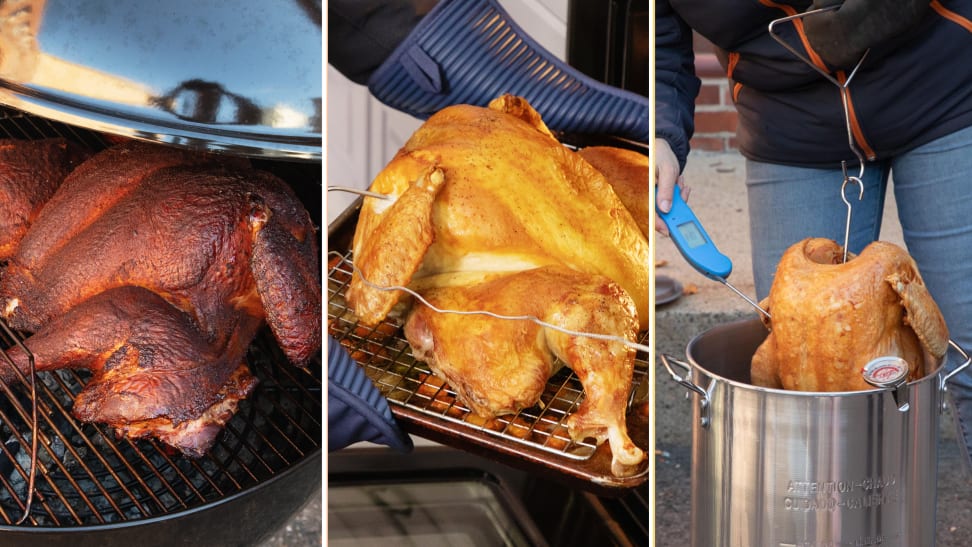 Credit:
Reviewed / Tim Renzi
Credit:
Reviewed / Tim Renzi
Products are chosen independently by our editors. Purchases made through our links may earn us a commission.
A few years back, at the first-ever Reviewed Friendsgiving celebration, we gathered more than 20 staffers and cooked three turkeys three different ways to find out which was the favored preparation. Smoked turkey, deep fried turkey, or roasted, spatchcock turkey—which is the best way to cook a turkey?
The spatchcock roasting method has always been our turkey-cooking recommendation, but we wanted to know if it would stand up to its smoked and deep fried competition. Beyond the taste factor, we also set out to determine which method was the easiest, quickest, and most economical.
How we prepped the turkeys

To achieve the spatchcock technique, use poultry shears to cut the backbone out of the turkey, flip it over, and give it a hefty press to flatten.
We started with three fresh turkeys, so no thawing time was necessary. Each turkey was dry-brined for 24 hours before cooking. We rubbed each bird with a mixture of Diamond Krystal Kosher salt and baking powder, as per the recommendation from Serious Eats, which gives an in-depth explanation of why dry-brining is superior to traditional water brining.
We appreciate this method for being far easier and less messy, plus dry-brining is all the turkey truly needs to retain plenty of moisture and flavor during cooking. The addition of the baking powder promotes browning and crispier skin. For the smoked version, spices were added according to the smoked turkey recipe.
The smoked and roasted birds were both spatchcocked (the culinary term for butterflied). The deep fried turkey remained intact, its more compact form better suited to the cooking vessel.
Spatchcocking, or butterflying, may seem unorthodox to some for this Thanksgiving centerpiece, but when you factor in the cooking time saved and the more evenly cooked results, it’s worth bucking tradition. Yes, removing the backbone from a large bird can be challenging, but with good poultry shears and proper instructions, even a turkey-cooking newbie can take it on.
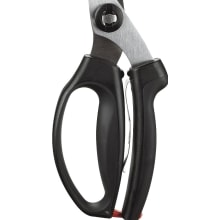
Our favorite poultry shears make spatchcocking turkey a breeze, thanks to the ergonomic handles, sharp blades, and spring-loaded design.
How we cooked the turkeys
Smoked turkey

The gorgeous color of the smoked turkey comes from a combination of the dry rub and the 2-plus hours of hardwood smoking.
The smoked turkey had the longest cooking time at approximately two and a half hours for a 12.75-pound bird. Yes, you read that right—just 2.5 hours. Since turkey doesn’t have a lot of fat or connective tissue to break down, like beef ribs or brisket, the smoking process is really all about flavor, and simply ensuring the bird is cooked through.
We chose to use a charcoal grill since many people already have them and their learning curve is less steep than a smoker, but you can also use a dedicated smoker and reap equally delicious results with even more temperature control.
We fired up the charcoal chimney, and followed the recipe directions precisely. We chose Turkey Perfect hardwood chunks, which don’t require any soaking before use, and placed them on top of our favorite charcoal, Royal Oak lump charcoal. Orienting the bird with the legs closest to the fire helps to protect the more delicate breast meat from overcooking.
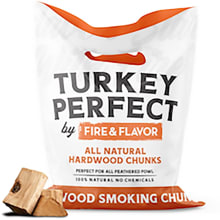
We used these flavorful wood chunks for the tastiest smoked turkey results.

The movable flap on the grill grate allows for easy adding of charcoal and hardwood to keep the fire and smoke going over a long cooking time.
Maintaining the temperature inside the grill was the biggest challenge, but with the flip-up cooking grate in our winning charcoal grill, adding fuel to the fire was relatively quick and easy. We named this bird Nigella and left her to cook under the watchful eyes of the Reviewed Lab team.
Roasted spatchcock turkey

While we love a good roasting pan for many cooking tasks, this spatchcock technique only requires a sturdy baking sheet and wire rack.
With bird number one under way, it was time to tackle the roasted turkey, which had an estimated cooking time of 80 minutes for the same sized bird. We loved the ease of preparation for this method. Since the dry-brining was done in advance, all that was left to do was give the skin a quick swipe of oil and place the turkey on a rack over a bed of chopped onions, carrots, celery, and a few thyme sprigs spread in a large baking sheet.
According to the recipe, this vegetable bed serves double duty: It prevents the drippings from scorching and creating acrid smoke, and it flavors the gravy you can make while the cooked turkey is resting.
We named her Julia and set the timer for 60 minutes to start checking her internal temperature.
Deep fried turkey

We set up the King Kooker fryer with some weights on the base to ensure extra stability, and controlled the flow of propane to adjust the temperature of the oil.
Finally, it was time to set up the deep fryer. With a cook time of only about 30 minutes, heating the large pot of oil took longer than the actual turkey-frying.
It’s important to pause for this crucial PSA: Deep frying a turkey is an inherently dangerous activity that should only be done outdoors by sober people who understand exactly what they’re doing and are using the appropriate equipment and safety precautions. Children and pets should be kept away from the area at all times.
We did all of this, and followed very specific instructions, to ensure the safest possible scenario.
We chose the King Kooker Propane Outdoor Fry Boil Package for its excellent reviews and real-life user videos. Following the very detailed Serious Eats recipe for deep frying a turkey, peanut oil is the recommended cooking medium due to its high smoke point.
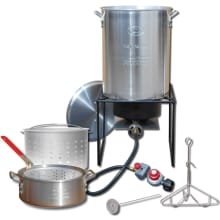
This kit includes almost everything you need to fry your bird on the big day.
We had no allergy concerns at our party, but if you do, vegetable oil is an acceptable substitute. It has a lower smoke point of 400°F, which shouldn’t be an issue because the oil temperature shouldn’t exceed 350°F. It’s obviously wise to monitor the oil temperature closely, no matter what oil you’re using.
A 12- to 13-pound turkey is the right size for deep frying, not only for optimal cooking time but also for ensuring adequate space in the cooker. If you’re serving an exceptionally large crowd, this quick-cooking method lends itself well to cooking two smaller birds, one after the other, rather than one larger turkey.
We ensured that the turkey was completely dry, which is another benefit of the dry-brining method. It was easy to position the turkey securely on the lifting rack. The King Kooker has a min/max line on the pot so there’s no guesswork about how much oil to use.
When our oil reached 350°F, we turned off the propane burner before slowly lowering the turkey into the oil. This ensured that if any oil splattered out of the pot during entry, none would be able to ignite.
Once the bird was safely submerged, we reignited the burner and adjusted the flow of propane as needed to maintain the oil at 350°F. We named this bird Guy, stood a safe distance from the bubbling pot, and set the timer for 30 minutes.
Nigella, Julia, and Guy—each weighing in at 12.75 pounds—cooked in the amount of time suggested by the recipes. We relied on the precision of the Thermapen ONE to check the internal temperature of all our birds, and let each rest for 15 to 20 minutes before carving.
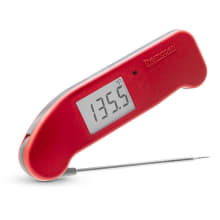
This digital meat thermometer helped us get a quick, accurate read on our turkeys.
Winner, winner, turkey dinner

The smoked turkey was favored for its flavor, texture, and uniqueness—not to mention its beauty.
While the roasted bird is certainly the easiest and least costly preparation, is it the tastiest? As you might have guessed…No, it was outranked by its more interesting competitors.
The smoked turkey came out on top, prized mostly for its novelty and abundant flavor. The thing about turkey is that it doesn’t inherently have a lot of flavor, so if you don’t specifically add some there’s not much there.
Smoking adds tons of flavor. From the spices added to the dry brine, to the hardwood over charcoal, and the 2-and-a-half or more hours of cooking time, smoked turkey has flavor to spare.
It wasn’t the juiciest bird at the party, but it was the most flavorful. Due to the less precise heat regulation inside of a charcoal grill—using lumps of charcoal, fire, and airflow rather than the electronic temperature control of an oven—it cooked a bit less evenly than the roasted version.
However, it still held on to enough moisture to meet our expectations for tenderness, juiciness, and overall enjoyability. In fact, it was ranked number one by half of the Friendsgiving guests.
Kitchen & Cooking team senior staff writer Monica Petrucci explained her rationale for giving it the top spot, “Some of the most common complaints about turkey are its dryness and lack of flavor, and this technique remedies both of those cons. Every bite was tender and flavorful—I didn’t even have to pile the side dishes on my fork to enjoy every bite.”
Reviewed chief scientist David Ellerby gave his honest feedback, “The smoked turkey was my favorite by far, partly for the novelty, and partly because I'm a major barbecue fan. In general, it was just a nice change of pace to have turkey that hadn't been slowly desiccated in the oven for so long the white meat had the texture of sawdust.” (Not that our roasted version resembled sawdust at all, of course.)
What about deep fried turkey?

The deep fried turkey came out golden brown and crisp, and took second place in our tasting.
Our deep fried turkey ranked second in this tasting, with many guests commenting on how surprised they were at the delicious results. Rachel Moskowitz, deputy head of audience development said, “I really thought I didn’t like turkey, because I usually find it dry and bland, but the deep-fried turkey method left the bird crispy on the outside, and juicy and flavorful on the inside.”
The peanut oil did impart a slight flavor on the bird and while many didn’t notice it, the peanutty undertone did throw off a few tasters. Those who liked the deep-fried turkey, however, really liked it. After all, it is moist and juicy with satisfyingly crisp skin.
While many were impressed by the results, they were also put off by the process. Ellerby commented, “The fried turkey was pleasantly moist, but the white knuckle terror of cooking it wasn't quite worth it.”
Deep frying is quick but can be dangerous and expensive
Our preparation and adherence to sound guidance made the process go smoothly (we still had the appropriate fire extinguisher at the ready). (More on deep frying your own turkey here.) But we’d heard, and Googled, far too many horror stories to take this cooking method lightly.
Some colleagues watched from about 10 feet away, while others preferred a balcony perch to witness the cooking from a greater distance. It certainly takes a lot of preparation and confidence to lower a large bird into a huge pot of very hot oil. You need to be ready for anything while keeping calm and collected. The last thing you want to do is drop that bird and splash the hot oil.
While this method might be riskier than others, it was the quickest we tried. Including heating the oil, the whole process took about an hour and a half. The deep fried turkey emerged from the oil fully cooked with golden brown, crisp skin and juicy interior in about 30 minutes.
However, that speed comes at a steep price—deep frying was the most expensive method of the three. In addition to the turkey itself, you need several gallons of cooking oil, which cost us almost $100, while the charcoal and hardwood for the smoked turkey rang in at only $30.
A charcoal grill is generally more expensive than a deep fryer, but they’re also more common and more frequently used. If you need to buy a deep fryer in addition to the turkey and oil, you’ll be in for another $80 to $100 or more.
Plus, you have to consider how to dispose of that much oil once you’re done with it. Avoid dumping oil down the drain because it can do serious damage to your plumbing. We recommend Fry Away Powder, which will solidify the oil so it can be disposed of in the trash. You’ll need to separate the oil into smaller quantities, and use a couple of packages of FryAway to solidify several gallons of oil.
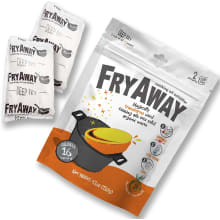
Dispose of your leftover oil easily with this solidifying powder.
Roasted turkey is still a great option

The spatchcock method may not have that traditional Thanksgiving look, but it sure does deliver the perfect golden brown color and delicious results.
It may have come in third in our taste testing, but it still won praise for its juicy interior and surprisingly crisp skin—thank you baking powder and dry-brining. We opted to leave this bird unflavored to let the cooking method shine, but there are so many options for adding flavorful herb butters or spice rubs to enhance the flavor.
Petrucci’s feedback was spot on, “Roasting turkey is a classic technique, but spatchcocking it beforehand is a game-changer. It needs just a fraction of the time in the oven, and it combats some of that dreaded turkey dryness. This option was less flavorful than the smoked, but with the right brine or herb butter, it can be an elevated classic.”
A spatchcock turkey may not look the most conventional, but the laws of physics have proven that it is a superior cooking method to leaving the whole bird intact. Sure, you can rotate a whole bird, tent it with foil, and try many other tricks to prevent the breast from drying out before the thighs are cooked through—but a butterflied turkey is going to naturally cook evenly without any tricks or hoop-jumping on your part.
If you’re shy about bringing a splayed out bird to the table, carve the rested turkey behind the scenes and save the table space for all those delicious sides. You can even separate the turkey onto multiple serving platters to save space and avoid too many “pass the turkey” requests.
Our top turkey-cooking tips

With a range of turkey-cooking experience under our belts, we've got the tips to save you headaches this Thanksgiving.
No matter how you choose to cook your turkey this Thanksgiving, here are a few tried and true tips for stress-free success.
- Buy a fresh, never-frozen turkey or make sure your frozen bird is thawing in the refrigerator for several days before you plan to brine it. (You’ll need 24 hours of thawing time for every 5 pounds of turkey.)
- Never deep fry a frozen turkey. If you’re going this route, ensure your turkey is fully thawed, with no ice left in the cavity, and fully dried before gently sliding it into hot oil.
- When in doubt, go smaller. A 12- to 15-pound turkey is easier to handle, will cook faster, and will serve a crowd—especially considering all the side dishes we love to indulge in this time of year.
- Go for the dry brine for fuss-free moisture retention.
- Get yourself a sturdy pair of poultry scissors and spatchcock your turkey if you’re going to roast or smoke it. It may look a little unconventional, but it’ll cook a lot faster and taste so much better.
- Read up on the recommended cooking temperatures for turkey, and use an instant-read thermometer to make sure you don’t overcook your bird. In a lot of cases, your turkey won’t take quite as long to cook as you think it will, so start checking early.
- Be sure you have a large enough cutting board, ideally with a channel, to catch juices before they run all over your workspace.
- Turkey-carving isn’t the easiest or quickest task, so why make guests wait while you struggle? Carve the turkey behind the scenes and serve ready-to-gobble pieces on a pretty platter.
What I’m cooking for Thanksgiving

From the Reviewed kitchen to yours, Happy Thanksgiving!
Despite being a professional chef for over a decade, I am technically hosting my first Thanksgiving this year. What’s my plan? I’ve already delegated some side dishes to relatives, ordered others from Home Chef, and am planning a dry-brined, herb-roasted, spatchcock turkey so I can go run a turkey trot in the morning before putting the bird in the oven.


